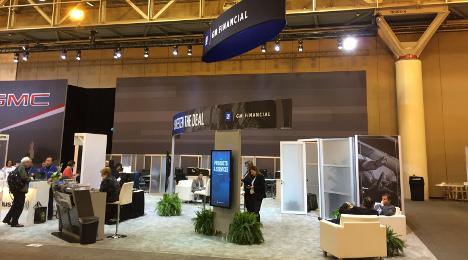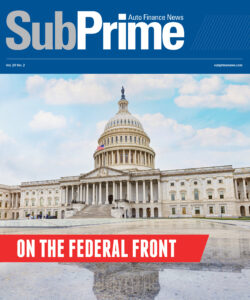GM Financial reinforcing AmeriCredit channel paying ‘dividends’

GM Financial's booth at this year's NADA Convention & Expo in New Orleans. (Photo by Joe Overby)
About a year ago, GM Financial restructured internal management to strengthen its AmeriCredit division — the original piece General Motors acquired almost seven years ago.
Since that point, GM Financial has since become the captive for the parent automaker. However, AmeriCredit remains a crucial cog in GM Financial’s operation, remaining as it has since its inception back in 1992 as a finance company that caters to the subprime market.
Just before GM Financial released its fourth-quarter and full-year results, SubPrime Auto Finance News connected with Paul Gillespie, who is the senior vice president for AmeriCredit sales and credit operations.
“I will say 2016 was very much for us like 2015 from an originations standpoint in the AmeriCredit channel, which was in line with our target,” Gillespie said. “We had not made any real material changes to our underwriting or pricing strategies so we’ve pretty taken the approach of ‘We’ll take what the market will give us on our terms.’ I think given to how we fit into the bigger picture of GM Financial, that is the approach we’re most comfortable with.”
The exact figures GM Financial released later showed that 12 percent of its North American originations fell into what the company classified as near-prime; contract holders with FICO scores between 620 and 679. The company indicated that it originated $1.065 billion worth of contracts in this tier during the fourth quarter.
What GM Financial classifies as deep subprime — customers with FICO scores below 620 — constituted 15.3 percent of its North American Q4 originations or $1.359 billion.
“We have dedicated sales, credit and management now to the AmeriCredit channel. It really has paid some dividends,” Gillespie said.
“We’ve seen some growth over the second half of the year. We are hopeful that will be a trend that will continue this year. Again, it’s really going to be on our terms. We’re not looking to grow artificially. We’re looking to grow along with our credit and pricing strategy dictating that,” he continued.
Gillespie emphasized that AmeriCredit’s relationships are solely with non-GM dealerships. Most of the little more than 8,000 stores in AmeriCredit’s active network are franchised operations while there are some independent dealerships, “but we’re pretty selective on how we quality independent dealers,” Gillespie said.
“It’s a little trickier space to manage but we do have those relationships and some are very good. But our primary volume and focus is on non-GM franchised stores,” he added.
While the company’s Q4 volume in near-prime and subprime softened slightly year-over-year — less than 6 basis points for both categories — Gillespie pointed out what’s encouraging about the characteristics of the paper that is coming into the portfolio.
“The one thing we’ve seen is consistency year-over-year with respect to through-the-door application scores as well as funded contract scores. We feel good about that,” he said.
“On the flip side of that, we have seen the market start to shift a little bit more to longer terms, even some lenders out there doing 84-month terms, and shifting their volume to 75-month terms. We don’t do any 84-month (contracts), and we do very little 75-month (contracts),” Gillespie continued. “We try to hold the line on term given the fact that this is subprime. Again, this fits our strategy of taking what the market will give us on our terms. That’s the nice part of being a part of GM Financial is we really don’t have an originations number we have to hit. This gives us a little bit of luxury relative to some of our competitors.”
Another advantage Gillespie mentioned is AmeriCredit’s access to the auto asset-backed securities market. Having been in business certainly helps, he said.
“We’ve had a long-standing relationship with the ABS investment community,” Gillespie said. “We’ve always had a great track record with the investment community. I think if you were to speak to any of them they would tell you we’ve always been very transparent in how we manage our business and what we share about our performance and what’s going into the portfolio.
“Having said that, our strategy is to continue to fund the AmeriCredit channel through the ABS market. At the same time, we’re going to be very consistent in what we’ve done in the past with them and maintain the relationships that we’ve built with the ABS market,” he went on to say.
The latest ABS assessment from S&P Global Ratings backs up Gillespie’s claims. Analysts said when evaluating the AmeriCredit Automobile Receivables Trust 2017-1, “Our expectation that under a moderate stress scenario, our ratings on the notes will not decline by more than one rating category from our preliminary ratings (all else being equal) over a 12-month period.”
It’s assessments like that one that triggered Gillespie to remark, “I don’t want it to sound like bragging, but I think we have one of the best relationships in the ABS market of any lender out there.”
With the first quarter nearly at its halfway point, SubPrime Auto Finance News closed its conversation by asking Gillespie about what he plans to watch closely as the year unfolds.
“The one that is top of mind for everybody is watching what happens with interest rates. After a long period of stagnation with interest rates, we’re starting to see a little upward climb, so making sure that we adjust our pricing as necessary to maintain our profitability targets,” Gillespie said.
“Secondarily, auction prices and used-car valuations, there’s a number of sources out there that have forecasted that we’re going to see declining valuations. So we’ve got to be cognizant of that and make sure if that is truly happening that we’re adjusting our approach to underwriting to reflect that,” he continued.
“Lastly, the continued expansion of term on contracts,” Gillespie went on to say. “We need to make sure that if that continues, that we have the proper balance of how much extended term we really are doing versus how much we’re uncomfortable with doing. It’s a little bit of a juggling act. It’s something we’re going to be watching closely, but our preference would be to stay where we are right now around that 72-month number and not migrate much north of that.”

 View The Latest Edition
View The Latest Edition

